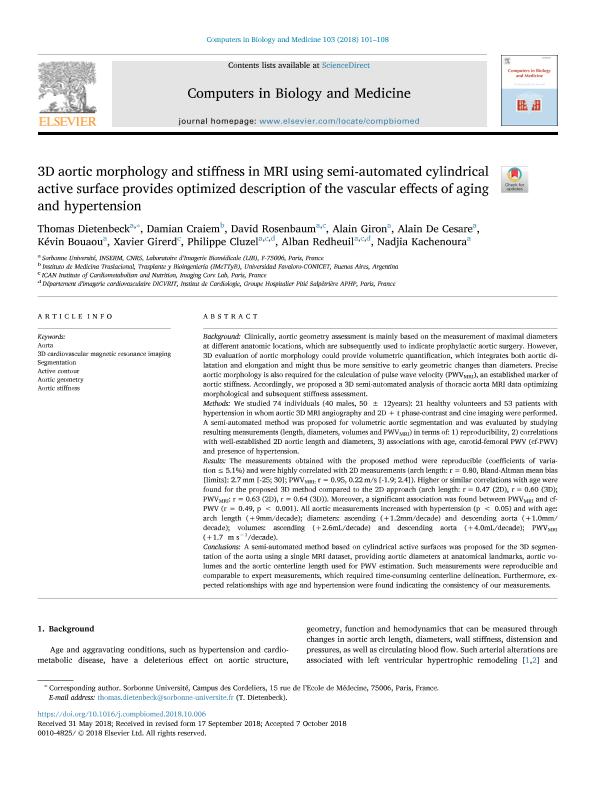Artículo
3D aortic morphology and stiffness in MRI using semi-automated cylindrical active surface provides optimized description of the vascular effects of aging and hypertension
Dietenbeck, Thomas; Craiem, Damian ; Rosenbaum, David; Giron, Alain; De Cesare, Alain; Bouaou, Kévin; Girerd, Xavier; Cluzel, Philippe; Redheuil, Alban; Kachenoura, Nadjia
; Rosenbaum, David; Giron, Alain; De Cesare, Alain; Bouaou, Kévin; Girerd, Xavier; Cluzel, Philippe; Redheuil, Alban; Kachenoura, Nadjia
 ; Rosenbaum, David; Giron, Alain; De Cesare, Alain; Bouaou, Kévin; Girerd, Xavier; Cluzel, Philippe; Redheuil, Alban; Kachenoura, Nadjia
; Rosenbaum, David; Giron, Alain; De Cesare, Alain; Bouaou, Kévin; Girerd, Xavier; Cluzel, Philippe; Redheuil, Alban; Kachenoura, Nadjia
Fecha de publicación:
12/2018
Editorial:
Pergamon-Elsevier Science Ltd
Revista:
Computers In Biology And Medicine
ISSN:
0010-4825
Idioma:
Inglés
Tipo de recurso:
Artículo publicado
Clasificación temática:
Resumen
Background: Clinically, aortic geometry assessment is mainly based on the measurement of maximal diameters at different anatomic locations, which are subsequently used to indicate prophylactic aortic surgery. However, 3D evaluation of aortic morphology could provide volumetric quantification, which integrates both aortic dilatation and elongation and might thus be more sensitive to early geometric changes than diameters. Precise aortic morphology is also required for the calculation of pulse wave velocity (PWVMRI), an established marker of aortic stiffness. Accordingly, we proposed a 3D semi-automated analysis of thoracic aorta MRI data optimizing morphological and subsequent stiffness assessment. Methods: We studied 74 individuals (40 males, 50 ± 12years): 21 healthy volunteers and 53 patients with hypertension in whom aortic 3D MRI angiography and 2D + t phase-contrast and cine imaging were performed. A semi-automated method was proposed for volumetric aortic segmentation and was evaluated by studying resulting measurements (length, diameters, volumes and PWVMRI) in terms of: 1) reproducibility, 2) correlations with well-established 2D aortic length and diameters, 3) associations with age, carotid-femoral PWV (cf-PWV) and presence of hypertension. Results: The measurements obtained with the proposed method were reproducible (coefficients of variation ≤ 5.1%) and were highly correlated with 2D measurements (arch length: r = 0.80, Bland-Altman mean bias [limits]: 2.7 mm [-25; 30]; PWVMRI: r = 0.95, 0.22 m/s [-1.9; 2.4]). Higher or similar correlations with age were found for the proposed 3D method compared to the 2D approach (arch length: r = 0.47 (2D), r = 0.60 (3D); PWVMRI: r = 0.63 (2D), r = 0.64 (3D)). Moreover, a significant association was found between PWVMRI and cf-PWV (r = 0.49, p < 0.001). All aortic measurements increased with hypertension (p < 0.05) and with age: arch length (+9mm/decade); diameters: ascending (+1.2mm/decade) and descending aorta (+1.0mm/decade); volumes: ascending (+2.6mL/decade) and descending aorta (+4.0mL/decade); PWVMRI (+1.7 m s−1/decade). Conclusions: A semi-automated method based on cylindrical active surfaces was proposed for the 3D segmentation of the aorta using a single MRI dataset, providing aortic diameters at anatomical landmarks, aortic volumes and the aortic centerline length used for PWV estimation. Such measurements were reproducible and comparable to expert measurements, which required time-consuming centerline delineation. Furthermore, expected relationships with age and hypertension were found indicating the consistency of our measurements.
Archivos asociados
Licencia
Identificadores
Colecciones
Articulos (IMETTYB)
Articulos de INSTITUTO DE MEDICINA TRASLACIONAL, TRASPLANTE Y BIOINGENIERIA
Articulos de INSTITUTO DE MEDICINA TRASLACIONAL, TRASPLANTE Y BIOINGENIERIA
Citación
Dietenbeck, Thomas; Craiem, Damian; Rosenbaum, David; Giron, Alain; De Cesare, Alain; et al.; 3D aortic morphology and stiffness in MRI using semi-automated cylindrical active surface provides optimized description of the vascular effects of aging and hypertension; Pergamon-Elsevier Science Ltd; Computers In Biology And Medicine; 103; 12-2018; 101-108
Compartir
Altmétricas



